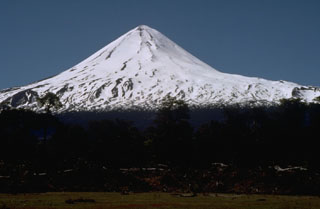Report on Llaima (Chile) — 30 January-5 February 2008
Smithsonian Institution / US Geological Survey
Weekly Volcanic Activity Report, 30 January-5 February 2008
Managing Editor: Sally Sennert.
Please cite this report as:
Global Volcanism Program, 2008. Report on Llaima (Chile) (Sennert, S, ed.). Weekly Volcanic Activity Report, 30 January-5 February 2008. Smithsonian Institution and US Geological Survey.
Llaima
Chile
38.692°S, 71.729°W; summit elev. 3125 m
All times are local (unless otherwise noted)
SERNAGEOMIN reported that eruptive activity at Llaima continued from the main crater and from multiple areas on the E flank during 30 January-4 February. An overflight on 28 January revealed Strombolian eruptions from a central pyroclastic cone in the main crater accompanied by emissions of ash and ballistic fragments. The craters surrounding the cone were incandescent and emitted bluish sulfur dioxide. Ash-and-gas plumes drifted WSW. A pyroclastic flow deposit was seen on the E flank. During 29 January-1 February, Strombolian eruptions were seen when weather permitted and emissions of ash and gases formed plumes that rose to altitudes of 3.6-6.1 km (11,800-20,000 ft) a.s.l. and drifted SW, SE, NE, and NW. Sporadic activity from the N and S lateral fissures on the E flank was also noted. During 1-2 February, ballistics propelled from the main crater landed both inside and outside of the crater. Strombolian activity declined on 2 February and steam and ash plumes rose to altitudes of 4.6-9.1 km (15,100-29,900 ft) a.s.l. and drifted NW. Emissions from multiple points along fissures on the E flank were noted.
On 3 February, material from intense Strombolian activity was propelled 500 m above the crater floor and fell inside and outside of the crater. Multiple lava flows from the W edge of the main crater descended about 150 m. Incandescent blocks from lava-flow fronts rolled down the flank. Plumes rose to an approximate altitude of 4.6 km (15,100 ft) a.s.l. and drifted WNW. Lava flows originating from a lava lake were observed during an overflight. These flows extended about 1.5-2 km in length and caused strong steam plumes due to their interaction with a glacier. According to a news article, about 20 people were evacuated from an area of La Selva, in the community of Vilcún (43 km W).
Activity was similar on 4 February. A phreatic explosion on the E flank was accompanied by steam plumes and a small pyroclastic flow. Orange ash emissions were noted from the S lateral fissure. Ash plumes from the main crater rose to an altitude of 6 km (19,700 ft) a.s.l. and drifted E.
Based on pilot observations, the Buenos Aires VAAC reported that ash plumes rose to altitudes of 4.6-6.7 km (15,000-22,000 ft) a.s.l. and drifted SE, NE, and W during 5-6 February.
Geological Summary. Llaima, one of Chile's largest and most active volcanoes, contains two main historically active craters, one at the summit and the other, Pichillaima, to the SE. The massive, dominantly basaltic-to-andesitic, stratovolcano has a volume of 400 km3. A Holocene edifice built primarily of accumulated lava flows was constructed over an 8-km-wide caldera that formed about 13,200 years ago, following the eruption of the 24 km3 Curacautín Ignimbrite. More than 40 scoria cones dot the volcano's flanks. Following the end of an explosive stage about 7200 years ago, construction of the present edifice began, characterized by Strombolian, Hawaiian, and infrequent subplinian eruptions. Frequent moderate explosive eruptions with occasional lava flows have been recorded since the 17th century.
Sources: Servicio Nacional de Geología y Minería (SERNAGEOMIN), ReliefWeb, Buenos Aires Volcanic Ash Advisory Center (VAAC)

